April 2017 Part 2
Lurch and Other Tales
We reluctantly finish our time on South Island
As fall settles in here in New Zealand, the butter has taken a stand — a firm stand, , complete with stiff upper lip — against being cooperative. Doesn’t matter where you put it — it’s mostly hard as a rock. We’ve gotten used to it. But warmer weather may lay ahead, at the northern end of this island; we can only hope.
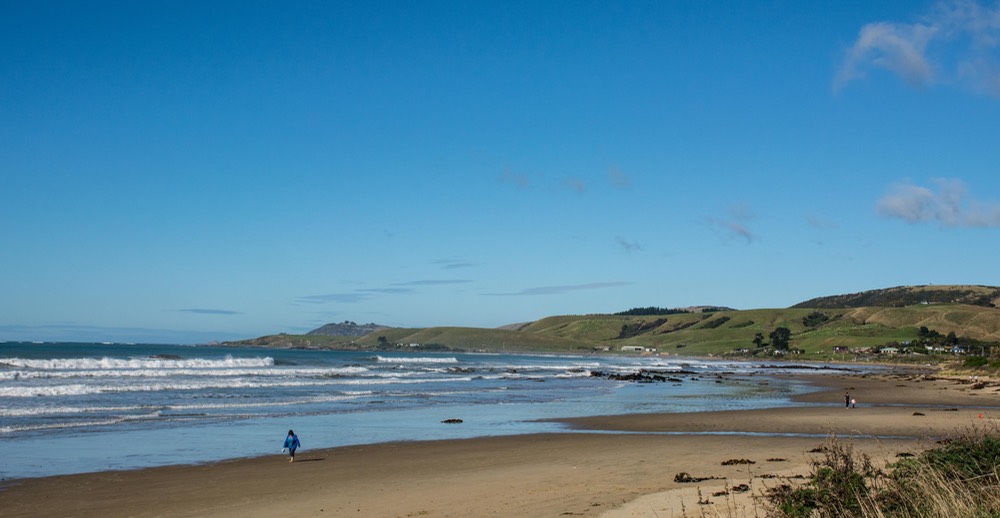
We left you in the shadow of Dunedin, in the southeastern corner of the New Zealand South Island. It was rainy and cold, and we’d headed inland for better weather and to survive the long Easter holiday. Leaving that cozy corner of the world, we started out on the adventure of traveling from Balclutha to Invercargill, along the rugged southern coastline. It was a great drive. We first traversed the pretty Catlin coast, making stops at various falls, bays, and beaches before ending the day near Fortrose.
One of our main goals along the way was to touch in at Slope Point, the southernmost point on the New Zealand mainland, but Slope Point managed to defeat us. Do you remember all that rain we we’ve been talking about ? Well, this southern route we’re discussing has occasional high spots, but mostly we were traveling in sodden, sloshy areas very close to water. One dip in the road was even accompanied by a sign indicating it was often inundated at high tide. So we were being careful. The campervan has rear wheel drive, but that’s not much.
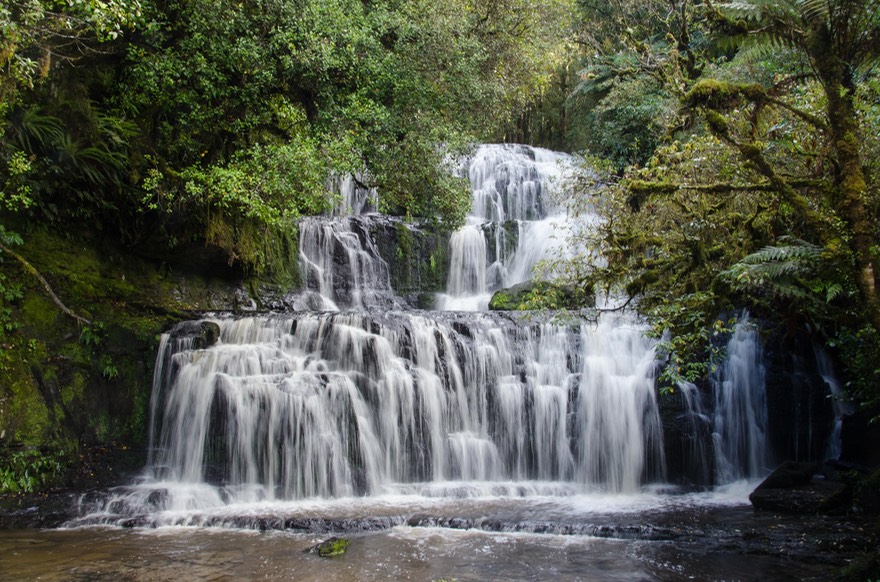
We found the car park area for Slope Point — from there it’s a short hike out to the end of the point — and it was very muddy; goopy even, not to put too fine a point on it . Rick said “noop — we’re not driving in there;” we managed to back out before getting stuck, did a gentle turn-around, and went on our merry way. At day’s end we were on a cliff (high and pretty dry) out towards sea from the village of Fortrose; we decided we’d done pretty well after all and had a lovely if cold and windy night of it. Our latitude at Fortrose was S46.58575, and we were just the teensiest little bit north of Slope Point. This will have to count as our furthest south point here in New Zealand. By comparison, when we were in South America, Ushuaia is at S 54.48 and is the southernmost city in the world.
Cold, you say? What’s the matter with the furnace? Well, as it turns out it had died and we were doing without its help at the moment. We were trying various things, hoping to get it going again. Also, the water heater had chosen to go on the fritz as well, so we were heating water on the stove. We’d called the emergency phone number for the rental company, and they tried but couldn’t give us enough info to do much.
We weren’t pleased, but knew that Invercargill was less than a day away now, so we kept on moseying along. We’re tough. Also, the probable solution to the problem was to exchange campervans, and even on our relaxed schedule that wasn’t a charming idea. Such a waste of time and energy.
So, we get to Invercargill, the southernmost city in New Zealand. We have plans for this city, things we want to do. As we drive into town, there’s a huge monument to the Invercargill participation in the Boer War (the locals call it the South Africa War). Click, click; photo op. A good start on the day. We’d come in on a Tuesday morning, put money in the meter and prepared to get some business taken care of. Hah!! Remember that “one more day of holiday” that the Southern area celebrates? Everything we needed was closed as the locals concluded a five day weekend.
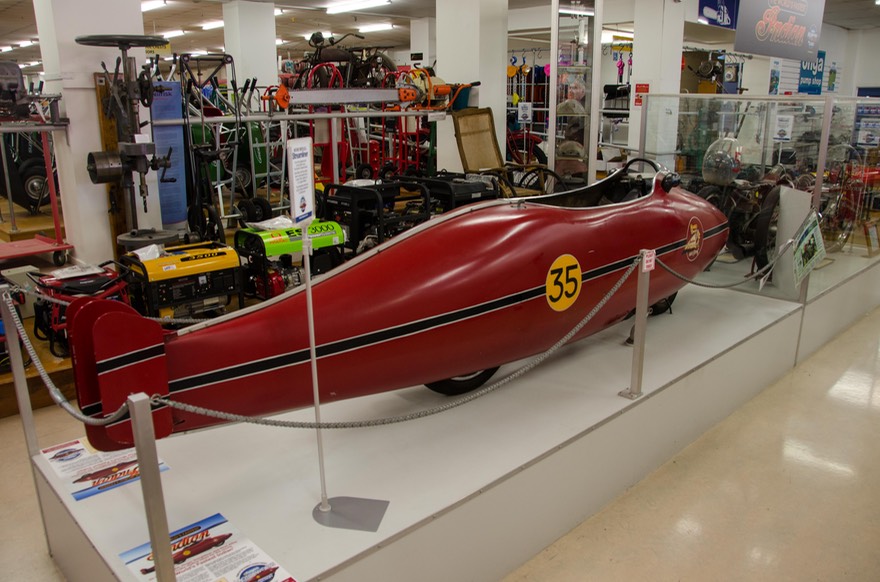
We had fun anyway. This is the home of the great Burt Munro, you know (“World’s Fastest Indian”). There’s a room dedicated to him in the Southland Museum, for starters, and also a very nice bronze statue out front. Also in the museum is a great display of tuataras (small dinosaurian reptiles found nowhere else in the entire world). Yes, they look like lizards; no, they aren’t and will stick out their tongues at you if you don’t stop saying they are.
But back to the inestimable Mr. Munro, the biggest scene in town was actually the E. Hayes Hardware store and Motorcycle Museum. Hardware you ask? Well, yeah, we say. It seems that Mr. Hayes and Mr. Munro were friends and before Burt’s death arrangements were made for Mr. Hayes to add Burt’s bikes and memorabilia to his already existing collection. It’s a cool store if all you want is hardware bits and tools, but spread around among these items is a pretty cool collection of bikes and cars with the highlight being Burt’s famous 1920 Indian Scout. By the way, if you haven’t had a chance to see the movie you really should. It’s a great story, lovingly told, and starring Anthony Hopkins to boot.
Invercargill is a great place. It and Dunedin are the only real cities on the south coast, and as we’ve pointed out, the only things between the two are bluffs and bays and birds and barnacles (barnacles? well, it’s alliterative, but we confess we didn’t actually see any). So there are repair shops, etc. On Wednesday Apollo found us an RV repair place that could take a look at our grumpy rig. Hmmm; needs a new circuit board for the furnace and the tank on the water heater is split and leaking; “we’ve seen lots like that, they don’t make this model anymore.” Apollo goes hmmmm; what shall we do? Eventually it was agreed that they would replace our campervan with a different one, and bring it to us in Te Anau, a fur piece up the road on the way to Milford Sound… on Friday.
Actually that wasn’t such a bad deal for us, but certainly a nuisance. Plus, it was cold! All of this was surprising because this was a pretty new van; a 2015 model with only 70,000 km on the odometer.
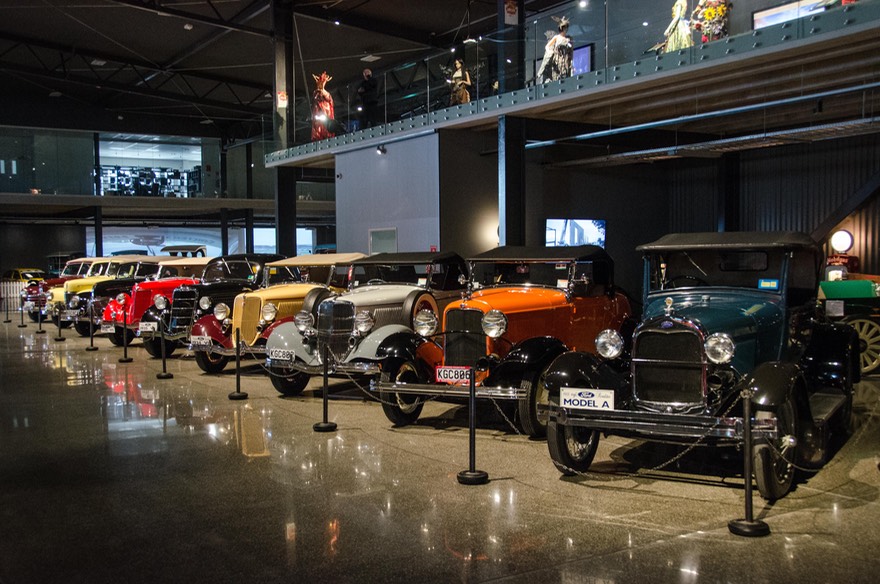
We spent the rest of Wednesday still in Invercargill. Rick had been given permission to do photoshoots at two more museums and that kept him busy for the day. The two are related to each other and both are pretty new. The Bill Richardson Transport Museum is housed in a purpose-built facility that covers an entire city block and only opened in late 2015. The Classic Motorcycle Mecca is newly opened (2016) in an older building downtown. New Zealand has turned out to be a real motor racing and aviation center and the number and quality of museums for motorized machinery is quite amazing. We knew that Australia has a lengthy motor racing history, but other than Rick knowing some famous Kiwi racing drivers, he hadn’t realized that New Zealand has been every bit as active. At any rate these two museums, along with the Burt Munro connection, stamp Invercargill as a real destination spot for motor-heads of all types. As time allows Rick will post photos from these spots and a number of others on Motor-Museums.com. For now, the first one to be posted is the Bill Richardson collection.
Then, Thursday morning we continued along the southern edge of the country, drifting through small towns and pleasant countryside. There was a very definite “end of the continent” feel, similar to what we’d sensed in far southern Chile. The road eventually turned north, along the eastern edge of Fiordland (yes, they spell it without the ‘j’ down here), and we moved on to Te Anau and the Visitor Center for Fiordland National Park, which includes Milford Sound along with a bunch of other cool things. This was a part of NZ where we really missed having our Tiger with us. Not only were we restricted by the rental contract as to where we could go, but more importantly there were the physical limitations of a low clearance, two wheel drive vehicle. Plus, had we brought the Tiger here we would have planned on a much longer time frame so the pressure to keep moving would have been much less.
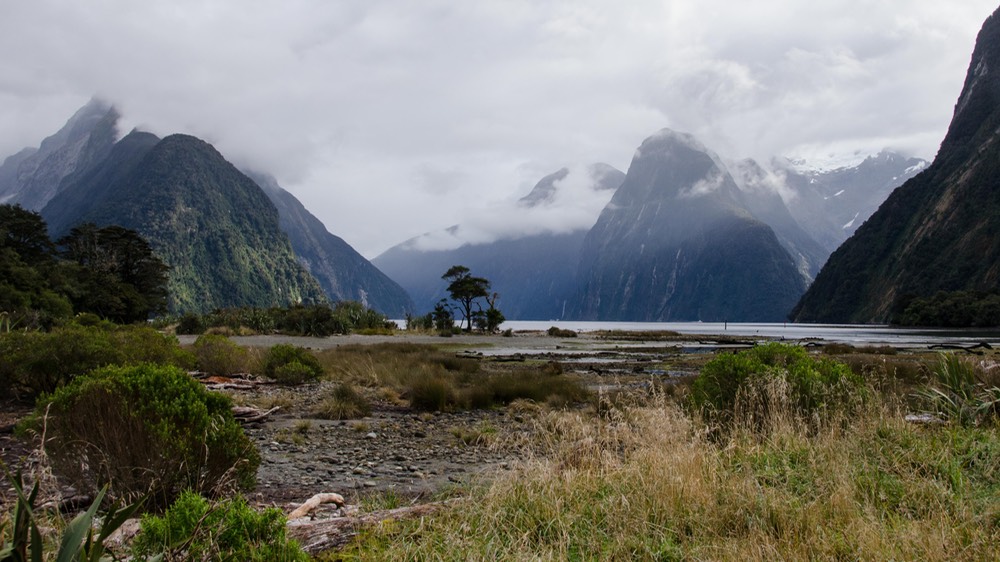
Te Anau is a great place, and we had good wifi at the library in town. We used it several times over the next couple of days as we tried to sort out getting the new van delivered and where to meet the driver.
The national park is a lovely destination. We camped part way out to the Sound, positioning ourselves to get ahead of the tour buses bringing people out for their boat trips. The road is in great condition Plenty of tight turns and few pull offs, of course. You even have to traverse a one-way tunnel with traffic lights to guide you. We were not fortunate with the weather the day of
The man bringing our replacement van finally showed up about 6:00 pm, after driving all the way from Christchurch, a very long day for the poor fellow. He was exhausted and we were anxious to get to a campground for the night, so we quickly exchanged vehicles, signed some papers and everyone got on the road. We settled in and then had to try and figure out where everything was going to fit in this new rig we’d just been given.
We hadn’t yet come up with a name for the first van; not really all that much personality to them when you think about it. But the second van named itself pretty darn quickly. The beast was christened Lurch. Leaping ahead just a bit so we don’t have to cover this ever again, in the end we will have had three rental vans while in NZ. They are all very similar Sprinter type vans and are the same size (6.9 meters long and 3.2 meters tall). The first and third vans were Mercedes models, while the middle one is a VW Crafter; that’s actually an identical van, as VW and Mercedes make them on the same line in Germany. Well these are nice, comfortable units, but very long and with a very long wheelbase that makes them slow to turn; nowhere near as nimble as our Tiger. The names we finally came up with for vans 1 and 3 are Scow I and Scow II in reference to their slow turning ability. At one time while negotiating a slow turn on a mountain road Rick said, “These things turn like a scow with too small a rudder.” Hence the name.
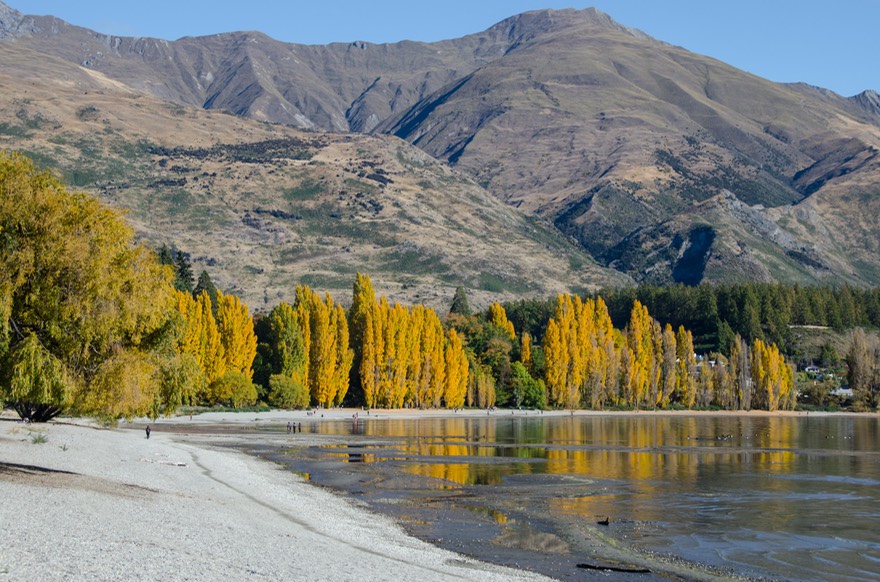
Well, Lurch is the same scow with the same rudder but he had one additional feature that set him apart and qualified him for his own name. Instead of the normal automatic transmission that both Mercedes vans had, Lurch was equipped with a Semi-Automatic tranny; no clutch pedal, but basically a manual gear box with an electrically operated clutch. If you feel the need to know more, send Rick an email. Not a bad system really, and being Rick, after a few days he got the hang of it just fine. Initially though, at slow speeds... well, it sort of Lurched a lot. We’ll leave it at that. We have ended up being quite at home in Lurch by now and will manage just fine until we can return him in Auckland.
Leaving the town we finally left the Fiordland area and started heading further north in South Island. We had a couple of weeks left down here and wanted to make the most of them. Our road to the western side of the island took us up the east side of Lake Wakatipu which borders on Queenstown, back through Wanaka, and up over the mountains to Haast, on the West Coast. Following SH6 we climbed to the top of the pass (563 meters), where it was quite misty and atmospheric, and then followed the Makarora River down to the Tasman Sea. (The Tasman Sea! Wow!)
The weather was clear again, and we were in the midst of a beautiful fall, with trees in yellows and reds and glowing in the sun. The sky was blue, it was warmer than on the southern coast, and we were doing well. The butter stopped looking so frigid.
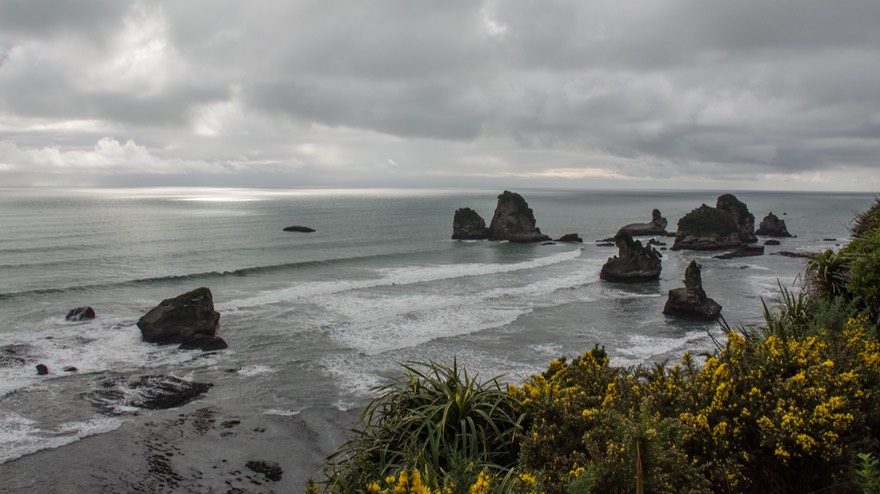
The West Coast was just plain super. For me, it’s the best we’ve seen in New Zealand so far. I love the coastal rainforest. The rugged road along the cliffs is just as nice as the Pacific Coast Highway in California, and with far fewer vehicles. The small towns with funky names (Hari Hari? or sometimes spelled Harihari?) — what can you do to top that?
Speaking of Harihari, on a Tuesday morning we happened to drive through Harihari at 11:00 am. It was ANZAC Day (April 25) and memorial services were underway all over the country. That’s the day that the New Zealand and Australian forces landed at Gallipoli in 1915, a terrible disaster of WWI that should never have happened. But the men fought bravely and made their countries very proud; they are honored every year, and there are many memorials to them. With the 100 year remembrance of the 1914-1918 war an ongoing occasion over the past few years many new memorials have been created and old ones refurbished.
Harihari did itself proud. There must have been 50 people there (the town’s population couldn’t have been much more than that); buses and cars had stopped and everyone got out to join in; there were active servicemen and women in uniform, a piper for “Amazing Grace”, speeches, a new statue to be dedicated, and a march down the middle of the highway to the cemetery for the traditional laying of wreaths. Could not have been more appropriate. Small town New Zealand came of age at Gallipoli.
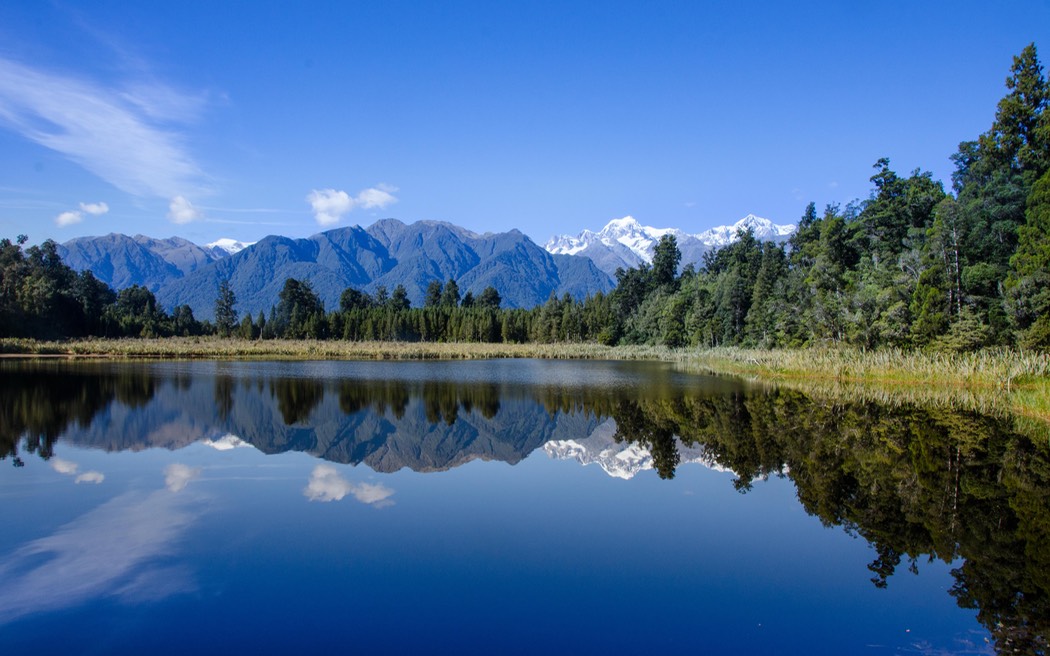
There are two glaciers to visit — Fox and Franz Josef — in Westland, as the West Coast is callled, and our guidebook (dated 2010) had said we should be able to get pretty darn close to both. Well, not in 2017. And you cannot walk on Fox Glacier these days, it’s too dangerous. If anyone besides Himself is still in denial about climate change, they need to come here. It’s very sad to see how these glaciers have retreated in such a short time. It was still a good experience.
Near the Franz Josef you can walk out to Lake Matheson, where there is a view of Aoraki/Mt Cook reflected in the quiet waters of the lake — unmatchable elsewhere. The mists had disappeared and it was a lovely day. People were in shorts and tee-shirts. Life is good!
We continued further up the West Coast, spending a night at pretty Lake Mapourika, next to the water. We kept going, stopping at intervals to enjoy the ocean and the views. Both in the evening and the morning we had good views of the mountains to the east, the same mountains we’d seen from Lake Pukaki looking west — the Southern Alps. This is a great area: ferns at your feet and alps in the distance. And pretty lakes to boot. Hard to resist.
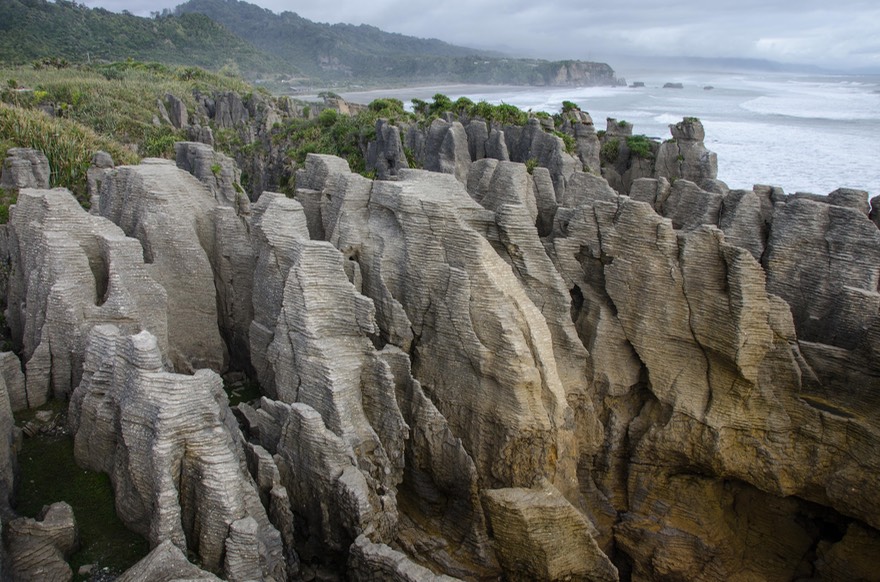
We went as far north as Greymouth and then to Punakaiki, where we had a super visit to the Pancake Rocks nearby. Yup — just like a huge stack of ‘em. Lots of stacks, actually. It was fun. We climbed around and took a bunch of pictures and enjoyed the spray from the surf. The wildflowers were everywhere now, including yellow broom, foxglove in the wet areas, and I even found some nasturtiums. Lots of color to enjoy.
Midst all this we had a new problem with Lurch — a warning light kept coming on saying we needed to dump in some Ad Blue, a diesel fuel additive, and telling us that in 2500 km the vehicle would stop working if we didn’t. (Isn’t this jolly?) This is a relatively new additive that was introduced in 2011 in Europe and the States, but is only part of the latest emission control requirements down here. Well — in all these little towns we found only one fuel station that even had the additive, but no one who knew where to “add” it. So we went on, working on solving this double problem — where to buy the stuff and where to pour it in. We did get it all figured out in time, but it was amazing that no one seemed to know anything about the stuff.
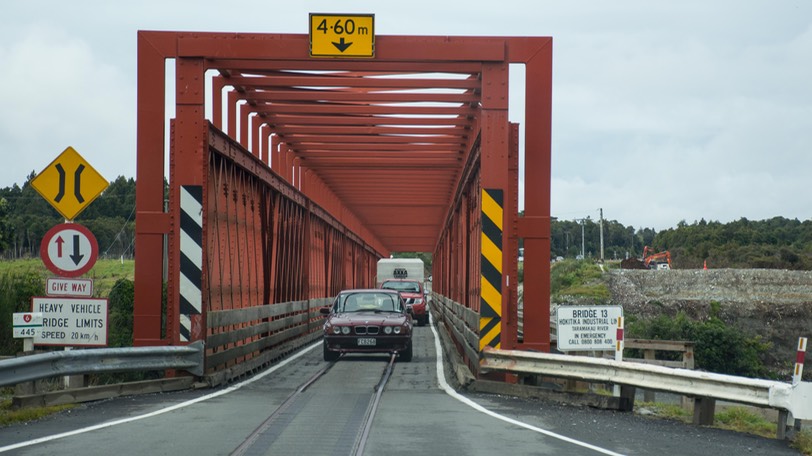
In our wanderings along the coast we went through Hokitika twice, both up and down. North of this small town is a longish one-way bridge; cool, no problem. But the deal is that you share the bridge with a train track, a working, functional train One that visits regularly. There are sort of weird signs using international symbols for trains and roads and putting the symbols on top of each other. But you’re a bit clueless until you get on the bridge itself. As I say, it’s a rather long and narrow bridge. And big semis use it, too. Life on the edge. By the way, rural New Zealand is filled with one lane bridges; they are everywhere. The distinction here is that this is the only one we’ve seen so far that is also shared with a train from time to time.
In making a decision of how far north to go along this rugged coast, we ended up scooting along because of the weather. We were hoping to get up to Cape Foul Weather, because of the name and to say we had, but we’re not huge foul weather folks. It looked like it was going to be just that; so we wimped out and started back towards the interior of the island, over Arthur’s Pass to Christchurch. And too, tempus was fugiting along as it always does.
We’d been told Arthur’s Pass was special, and there’s lots to see. It crosses the Alps among pretty high peaks and in winter it would be spectacular. Now, at the end of April (very much Fall) it’s quite dry and inhospitable, but very dramatic.
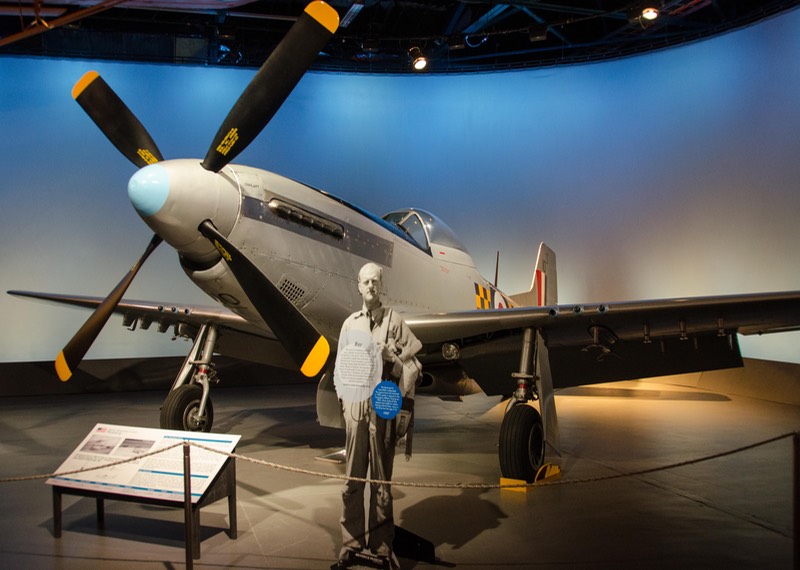
We wanted to see our friends in Christchurch one last time, and so we altered our route in order to find them at home, had a brief visit, and then wandered a little in that area. We’d also returned in order to visit the nearby National Air Force Museum, which turned out to be a pretty cool place. Modern museums these days are doing very interesting things with color. The large exhibit space is often very dark, and the featured planes are highlighted in blue, or yellow, etc. It’s very dramatic. In this museum, also, they have made a big effort to talk about people from New Zealand’s aeronautic history and people in the field today. It’s quite effective. There are life-size cutouts of many people; you can stand next to them and have a nice chat, even if it is a tad one-sided.
There is also an excellent exhibit on the events leading up to and during World War I. It is very nicely presented, with an emphasis on local history. A good job and quite informative.
Leaving the Christchurch area we tooled around the Banks Peninsula for a bit, enjoying the views of the bays and getting ourselves into deep trouble on the winding roads with their hairpin turns. It seems our GPS hasn’t changed one whit: it still ignores our vehicle’s configuration and always goes for the fastest and most direct route anywhere — and we take it in the shorts. If you ever get to Kiwiland and are in a campervan, do not, I repeat do not, take the road over Dyer’s Pass. You’ll know it when you see it!
We rewarded our survival of this small nightmare by stopping at a bakery we knew of that was near Lytttelon, The French Bakery, at 238 Port Hills Road. Do Write that down. This little gem is worth searching out. We had eaten meat pies from this great place, and we’d both loved them and vowed to find the source if we could. Thanks again, Peter and Margaret! Not surprisingly, we discovered that they also did very interesting things with chocolate, and pecans, and lemon meringue, and, and… A certain amount of stocking up was called for.
Finally fleeing the Christchurch area and heading north toward the top of South Island, we knew we were running out of time. We’d lingered too long and needed to get going. And some of the best was still ahead! So we got busy.
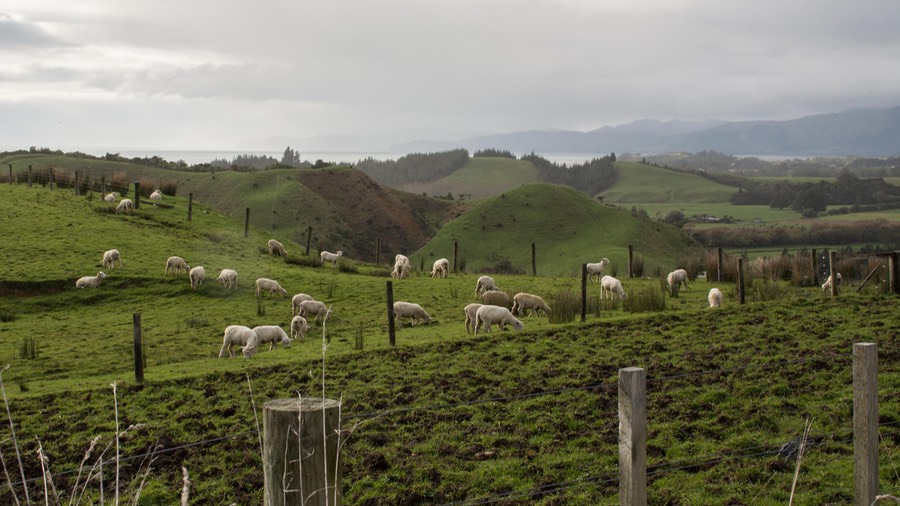
Along the roads we were seeing potatoes and pumpkins for sale, and “end of summer” crops, with lots of apples and pears. The weather was good, and there was lots of sun, so it was warmer. Good! We stopped one night at a small country park with a big field. The next morning we watched a couple of older guys flying their model airplanes, along with folks giving horse riding lessons, birds in the branches of the trees, and a lot of dogs running around chasing pine cones and other thrown objects. Quite charming and oh, so normal.
We moved north into the Nelson and Abel Tasman NP areas. We had a beautiful drive that day, one of the best so far. As you move off the flatlands and into the interior it gets hillier and even mountainous, going up SH7. Up and over Lewis Pass at 917 meters — just great. We thought this was the most attractive pass we’d crossed yet, despite doing it in wet and cloudy conditions. We spent the night above where SH63 turns up towards Richmond and then Abel Tasman, at 350 meters…and 0℃ overnight — inside the van. Oh, and the heater in Lurch isn’t working now, either. We are resorting to starting the van in the morning to run the engine heater before we get out of bed. But the trees are gorgeous, all golden and red and orange. It’s quite a show. We are very happy to be able to tour here in the fall.
It was now Tuesday and we needed to be all the way across to the east side of the island by Thursday noon. We followed the little roads we were allowed on (no gravel, remember), poked around in some of the bays, and drove northwest as far as Collingwood, where we were facing a tough winding and narrow road in wet weather, wanting to visit Farewell Spit. In the end we didn’t; we needed to turn east. Now getting into some rain, but we didn’t care. The fall color was just great, and if it was too misty for the colors to really shine through, we’d now seen enough that we could fill in the blanks ourselves.
We are starting to see our first “closed for winter” signs on campgrounds up here at the top of South Island (early May). But the fields are green, the valleys lovely. Heavy frosts in the mornings; but the days are warmer up here. They say Nelson is the sunniest spot in New Zealand; seems it could be true. And the butter is soft as jam by dinner time; not so much at breakfast.
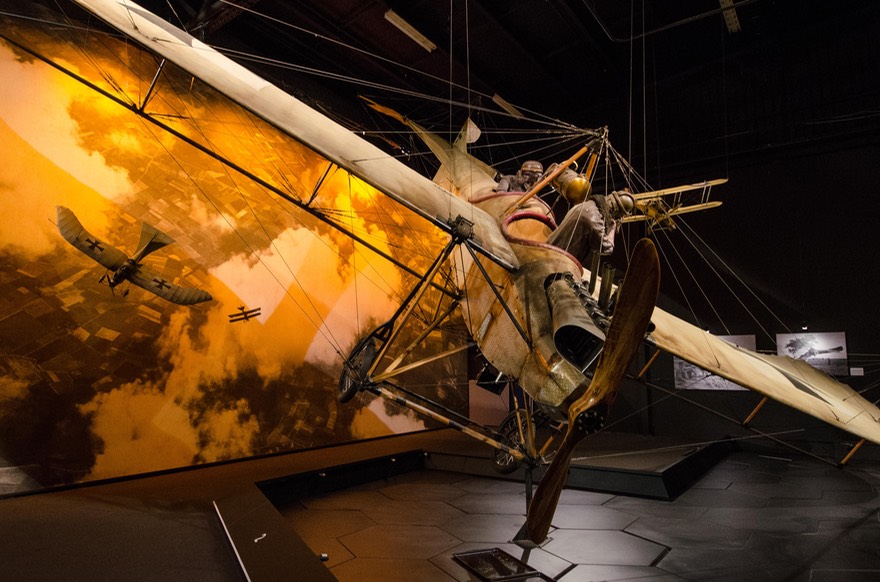
We spent one last night in the mountains, in a beautiful sparkly picnic area east of Nelson. All the colors were brilliant in the morning when the sun cleared the mountains; it was a great and fitting end to our wanderings in South Island.
Well, almost. We were headed toward our ferry, but detoured to Blenheim to see another aviation museum, The Aviation Heritage Center. The museum is actually in Omaka, just outside of Blenheim and was founded by director Peter Jackson. It is well known not only for the WWI aircraft in the collection, but also for the dramatic exhibits of the planes in life-like scenes created by Jackson and his movie-making colleagues. Well, I’ll tell you, it really is quite a place and well worth a visit. There are actually two allied museums in operation here, the original WWI exhibit, where we believe all the planes are actually owned by Jackson, and a more recently opened WWII collection with planes provided by other collectors. The museum is located at the Omaka airfield and during our visit a couple of the WWII planes were being given some exercise so we got to see and hear them take off and land, etc. Really cool, and the exhibits lived up to every bit of their reputation.
Late in the afternoon we headed up the road to Picton, the ferry terminal and our last evening in South Island. We rewarded ourselves with a terrific, really terrific dinner of fish and chips — blue cod and a scoop of fries (be careful, a “scoop” is really big). Yummy. Then got up at 6:00 am to catch the ferry and start our adventures on North Island.
Our first chore will be to make a dash up to Auckland, where we must return Lurch to his handlers, and pick up our new wild beast for our next set of adventures. We will have about five weeks in which to enjoy North Island before flying to Australia to meet the Tiger.
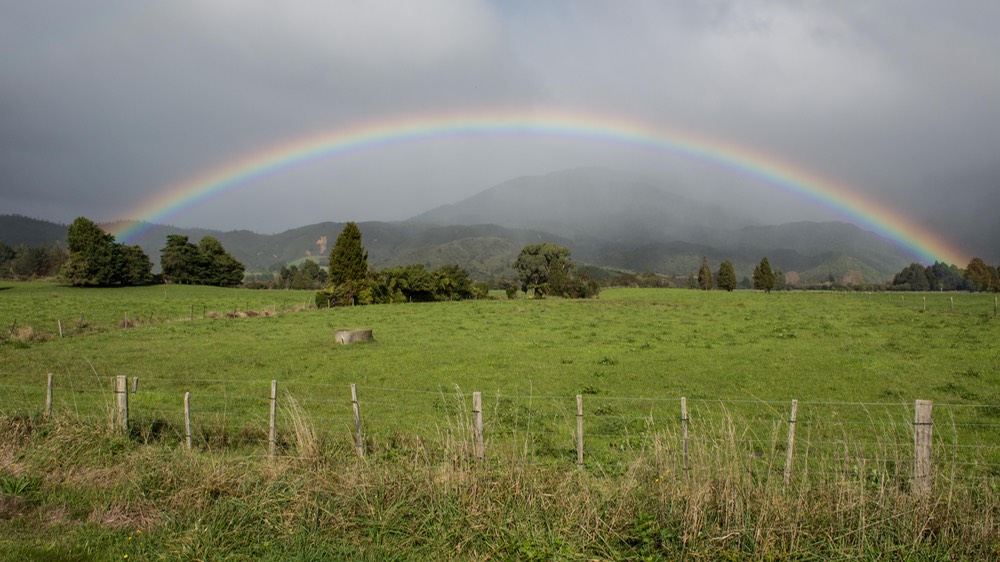
You may be wondering why so many vans. Well, it’s logistics, as always. When we made our first decision to rent a camper van in New Zealand, we thought we’d be here for 5 weeks total; we decided to allot four weeks for South Island and one week for North Island. Then we found out the Tiger’d been delayed and we’d actually be here for ten weeks total. Apollo wouldn’t let us keep what we already had, so we had to arrange for a second rental. And since we’d already contracted to return that first van to Auckland, they made us honor that contract. Thus a dash to Auckland to drop off one and pick up a different vehicle. It was all very stupid and aggravating, but cast dies cannot be recast…..
We enjoyed South Island a lot. We have found that New Zealand is more quietly lovely than wildly dramatic except in “special” spots. There’s a real sense of community here, and lots of very industrious workers. The towns are filled with pretty, tidy parks and places for the folks to get out and enjoy themselves, which they do. We could live here if they’d let us. In fact, we’ve come up with a slogan for NZ paraphrased from a common saying: “New Zealand, a great place to visit and an even better place to live”.
Whadya think? We’ll get back at you in a few weeks with our impressions of the rest of the country.
Rick and Kathy and Lurch, The Beast that Thought He was a Motorhome.
Click to see more photos from Lurch and Other Tales